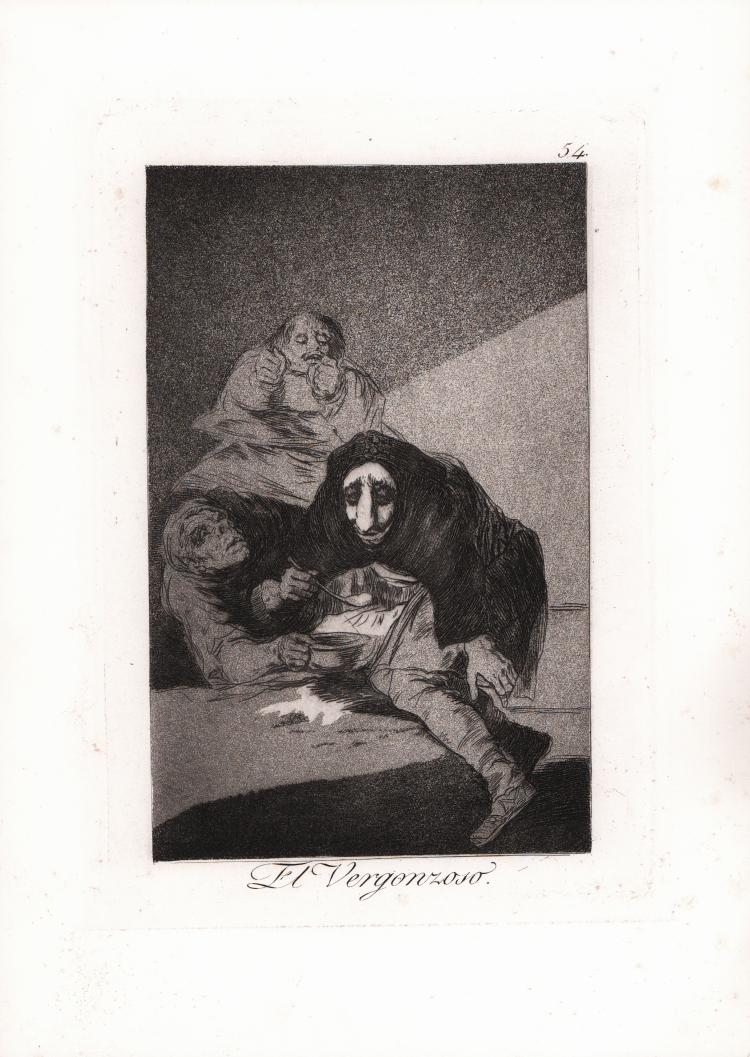



| Reference: | S7078 |
| Author | Francisco de GOYA Y Lucientes |
| Year: | 1799 ca. |
| Measures: | 145 x 210 mm |


| Reference: | S7078 |
| Author | Francisco de GOYA Y Lucientes |
| Year: | 1799 ca. |
| Measures: | 145 x 210 mm |
Etching with burnished aquatint and engraving, 1799.
From the fourth edition of twelve of the so-called Los Caprichos series, edited by the Madrid Calcografia [circa 1870].
A very good impression, with good contrast, printed on contemporary paper, usual wide margins, in very good conditions.
The series called Los Caprichos, consists of eighty etchings. This first edition of 1799, the only one not to be published posthumously, is imprinted on soft laid pape.
Cured in phase edition by the same artist, the series was marketed and before long withdrawn from the market. In fact, because of the many subjects that mocked the Spanish society of the century, Goya suffered censorship.
The interpretation of the subjects represented on these plates, always enigmatic, is often controversial.
In this print Goya approaches the theme of the world upside down. In the scene there are three characters, being the focus of attention the man who is eating, and tries to avoid all eyes, ashamed of the obscene features of his face. The artist has clearly indicated his thinking by drawing above the character's head the waistband of a pair of pants. The noses take on a notable presence on the face, and in popular language "noses" is a clear sexual euphemism. The way the face is constructed, so that eyebrows, eyes and nose evoke the male genital apparatus, would reinforce the same sense. Other comments insinuate that the figure, in the upper plane, with his large clenched fists, is committing sodomy with the figure holding the vessel from which the shameful man eats. The year 1799 is one of the key moments in the life and work of Francisco de Goya. In addition to being named first chamber painter, enjoying a growing prestige as a portrait painter and the inauguration of the chapel of San Antonio de la Florida, which he had decorated, on February 6 the announcement of the sale of the eighty prints that form the series of the Caprichos was published in the Diario de Madrid.
Here, Goya focuses his social criticism on the bestiality of a deformed man whose head emerges from his breeches. Among the slight variations between the print and the preparatory drawing, the most striking is that, in the former, he wears his trousers, but in the latter, he does not. As a result, the latter came to be known as The satire of man’s lechery. Moreover, this is the only drawing in the series to mix red-ink wash with pen. Valentín Carderera’s handwritten commentaries on the Caprichos, which are in both the Biblioteca Nacional and the Museo del Prado, further clarify this subject. The first reads: Men with large noses also tend to have large arrows [here, “arrow” is a euphemism for penis] and fat gandumbas [testicles]. As they are often sodomites, this one is depicted with his breeches on his head, with his pudenda hanging out as he lies on top of a poor devil and pulls up his skirts. The second commentary completes the information: There are men whose face is the most indecent part of their body, and it would be good if those whose face is that disgraceful and ridiculous would stick it in their breeches.
Example fomr the HENRI MARIE PETIET (Saint-Prix, Seine-et-Oise, 1894-1980) collection (Lugt 5031).
|
Harris 89; Delteil 91.
|
Francisco de GOYA Y Lucientes (Fuente de Todos 1746 - Bordeaux 1828)
|
Spanish painter, draughtsman and printmaker. The most important Spanish artist of the last quarter of the 18th and first quarter of the 19th centuries, he served three generations of Spanish kings. Stylistically his work spans the period from the late Rococo to Romanticism and, at the last, presages Impressionism. During his six active decades he produced some 700 paintings, 900 drawings and almost 300 prints, which reflect his rapidly changing world: the Bourbon Spain of Charles III and the reign of Charles IV, the Enlightenment, the French occupation, the turmoil of the Peninsular War, the despotic reign of Ferdinand VII (and the Inquisition) and Spain’s few years of constitutional government. Appreciation of his prints by non-Spaniards even during his lifetime soon ensured his reputation abroad. Known by 1801 as the ‘Apelles of Spain’, he has been regarded since as a major master of international stature and as the first ‘modern’ artist.
|
|
Harris 89; Delteil 91.
|
Francisco de GOYA Y Lucientes (Fuente de Todos 1746 - Bordeaux 1828)
|
Spanish painter, draughtsman and printmaker. The most important Spanish artist of the last quarter of the 18th and first quarter of the 19th centuries, he served three generations of Spanish kings. Stylistically his work spans the period from the late Rococo to Romanticism and, at the last, presages Impressionism. During his six active decades he produced some 700 paintings, 900 drawings and almost 300 prints, which reflect his rapidly changing world: the Bourbon Spain of Charles III and the reign of Charles IV, the Enlightenment, the French occupation, the turmoil of the Peninsular War, the despotic reign of Ferdinand VII (and the Inquisition) and Spain’s few years of constitutional government. Appreciation of his prints by non-Spaniards even during his lifetime soon ensured his reputation abroad. Known by 1801 as the ‘Apelles of Spain’, he has been regarded since as a major master of international stature and as the first ‘modern’ artist.
|